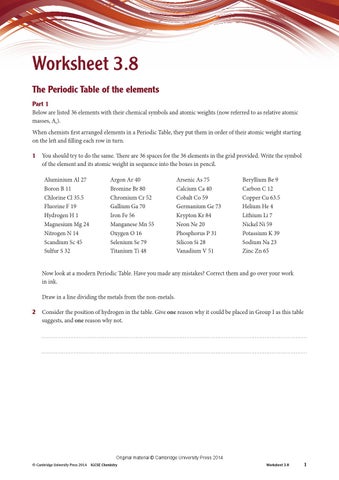Worksheet 3.8 The Periodic Table of the elements Part 1 Below are listed 36 elements with their chemical symbols and atomic weights (now referred to as relative atomic masses, Ar). When chemists first arranged elements in a Periodic Table, they put them in order of their atomic weight starting on the left and filling each row in turn. 1
You should try to do the same. There are 36 spaces for the 36 elements in the grid provided. Write the symbol of the element and its atomic weight in sequence into the boxes in pencil. Aluminium Al 27 Boron B 11 Chlorine Cl 35.5 Fluorine F 19 Hydrogen H 1 Magnesium Mg 24 Nitrogen N 14 Scandium Sc 45 Sulfur S 32
Argon Ar 40 Bromine Br 80 Chromium Cr 52 Gallium Ga 70 Iron Fe 56 Manganese Mn 55 Oxygen O 16 Selenium Se 79 Titanium Ti 48
Arsenic As 75 Calcium Ca 40 Cobalt Co 59 Germanium Ge 73 Krypton Kr 84 Neon Ne 20 Phosphorus P 31 Silicon Si 28 Vanadium V 51
Beryllium Be 9 Carbon C 12 Copper Cu 63.5 Helium He 4 Lithium Li 7 Nickel Ni 59 Potassium K 39 Sodium Na 23 Zinc Zn 65
Now look at a modern Periodic Table. Have you made any mistakes? Correct them and go over your work in ink. Draw in a line dividing the metals from the non-metals. 2
Consider the position of hydrogen in the table. Give one reason why it could be placed in Group I as this table suggests, and one reason why not.
Original material Š Cambridge University Press 2014 Š Cambridge University Press 2014 IGCSE Chemistry
Worksheet 3.8
1
